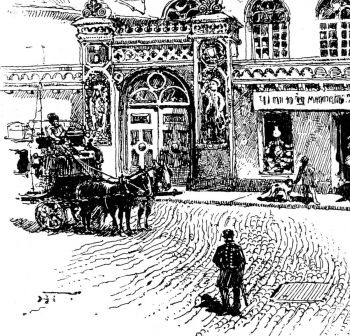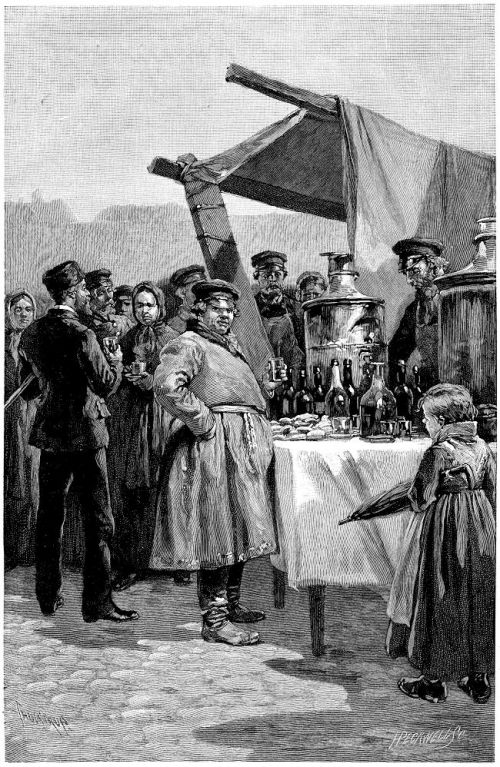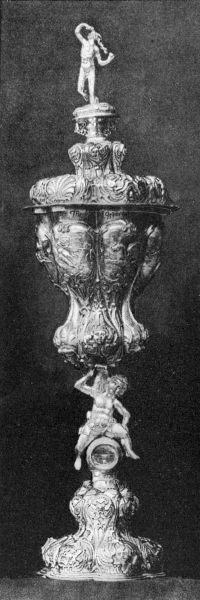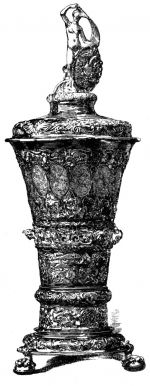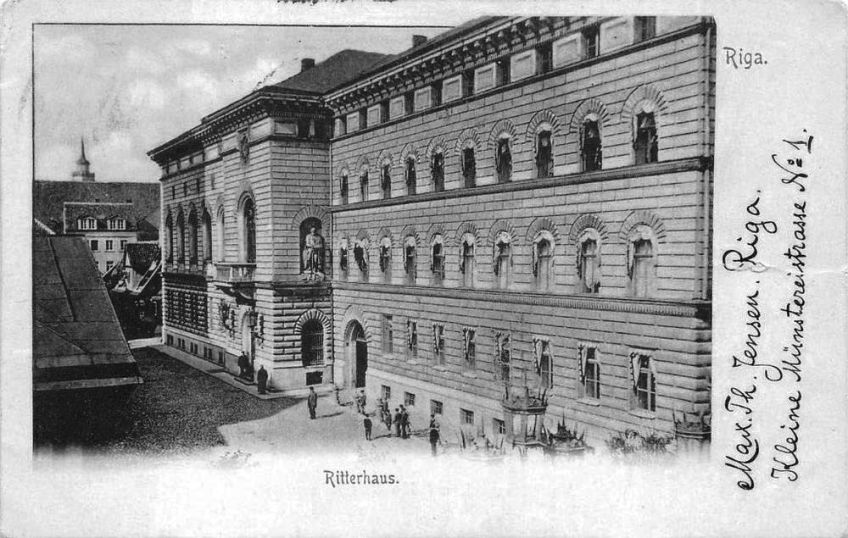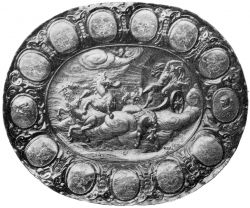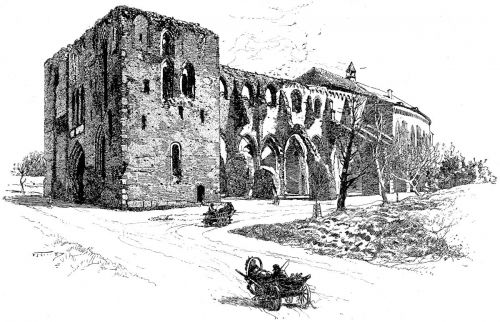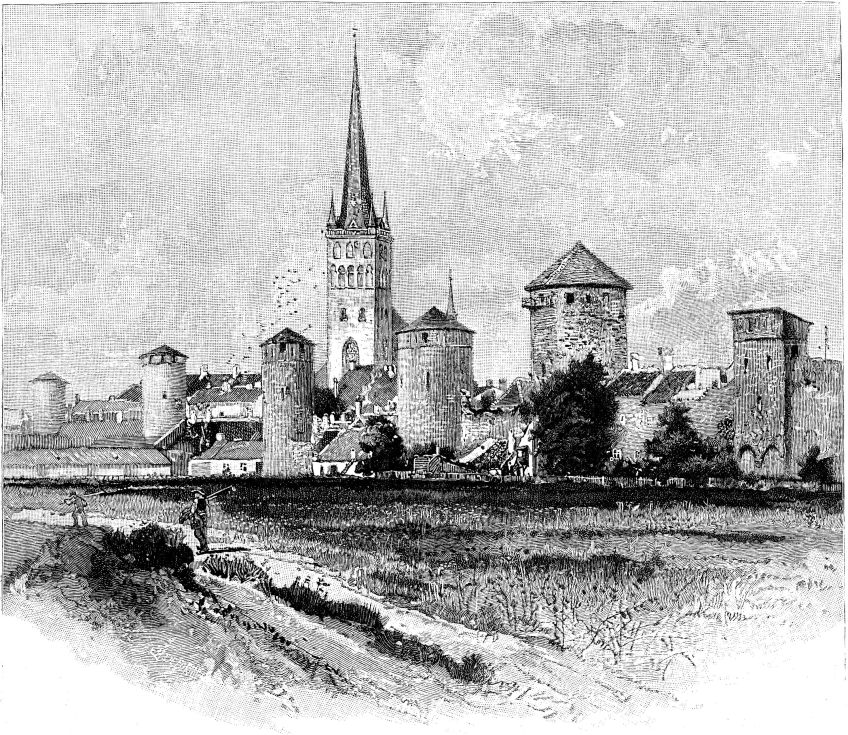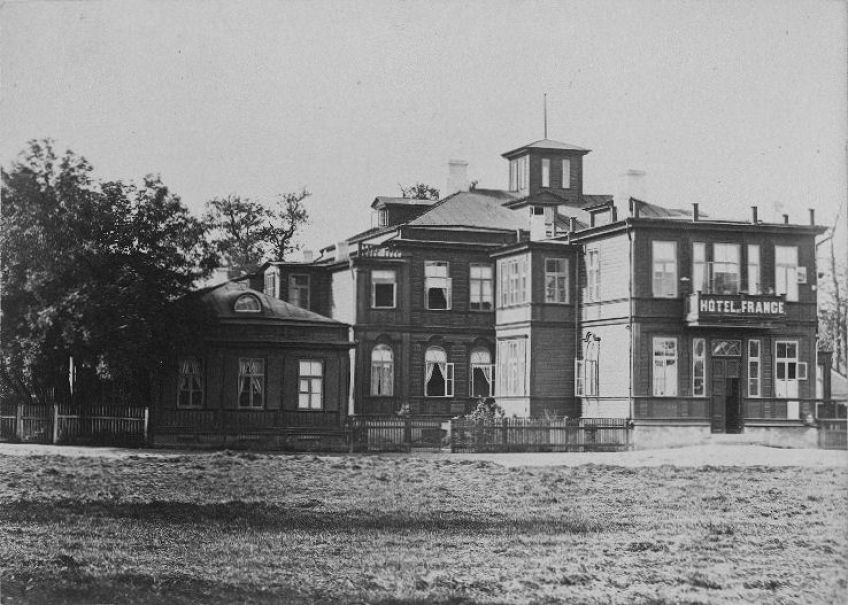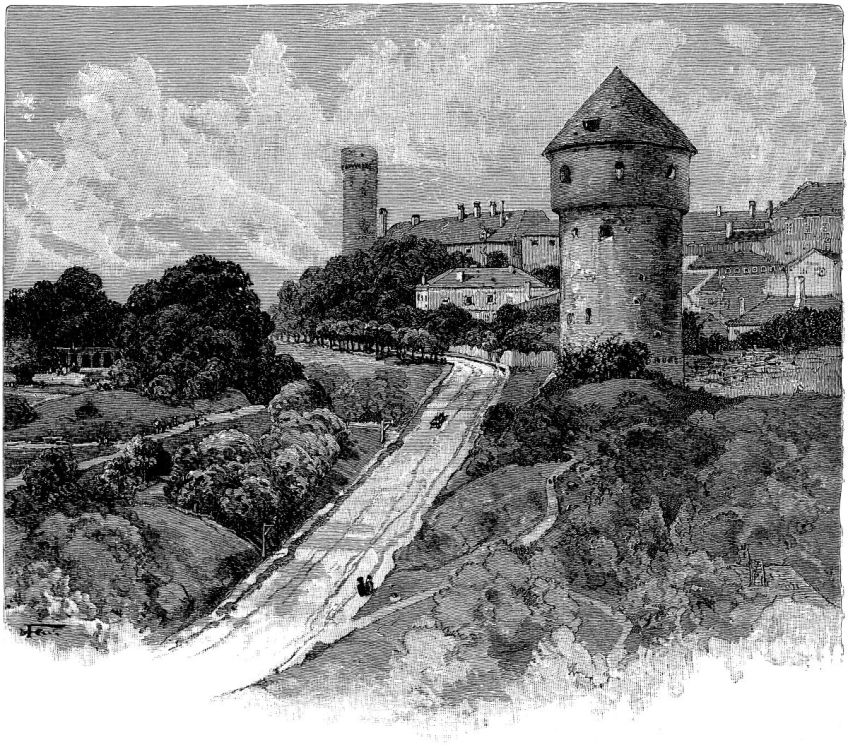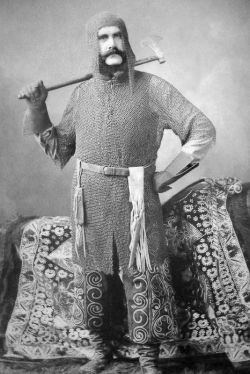
Henry Lansdell—minister, author, explorer
As the end of the 19th century approached, Riga was a hub of manufacturing and international commerce—third in size only behind Moscow and St. Petersburg in industrial workforce in the Russian Empire.
The histories of Riga and of Latvia are inexorably entwined. While Riga is the cosmopolitan attraction, for as Henry Lansdell writes: "Here an Englishman who speaks German may feel nearly as much at home as in Prussia or Switzerland, and may study the many curious questions connected with a Lettish and Esthonian peasantry living with a Teutonic aristocracy, and all governed by autocratic Russia," the curious—such as Lansdell—could not but become interested in the indigenous Latvians as well. And so, owing to Riga’s role as a center of commerce for centuries, far more accounts of Riga and her history, along with that of its inhabitants and their land, are available than might be otherwise.
Henry Lansdell (1841–1919) was a retired minister who traveled widely, taking with him an insatiable curiosity which, judging by his writings, opened many doors, offering insights afforded to few others. His journeys across Russia ranged from the Baltics to Vladivostok. Wherever he traveled he documenting everything from flora to local penal systems—bringing the Bible to the imprisoned was a personal quest. A contemporaneous who's who of Christian personalities writes1:
LANSDELL, Henry DD. (by Archbishop Canterbury and Queen's letters patent, 1882), Church of England; born at Tenterden Kent January 10, 1841; educated in the London College of Divinity, 1865–67; was ordained deacon 1867, priest 1868, curate of Greenwich 1868–69; secretary to the Irish Church Missions 1869–79; founder and honorary secretary of the Homiletical Society 1874–86; originator and editor of The Clerqyman's Magazine, 1875; curate in charge of St. Peter's Eltham Kent, 1885. He is a member of the Royal Asiatic Society, and of the General Committee of the British Association for the Advancement of Science (life member, 1880); fellow of the Royal Geographical Society, 1876. He has not only since 1870 journeyed the world, and with two exceptions every country of Europe; but he has visited of Siberia, Central Asia, Bokhara, and Khiva, where no Englishman had preceded him. Since 1874 he has gone not only as traveller, but amateur missionary, distributing tracts through Denmark, Sweden, Finland, and Russia, 1874; Norway and Sweden, 1876; Hungary and Transylvania, 1877; tracts and Scriptures through Russia, 1878; Siberia, 1879; Armenia, 1880; Central Asia, 1882. He is the author of Through Siberia, London, 1882, 2 vols. 5th ed. 1883; Russian Central Asia, including Kuldja, Bokhara, Khiva, and Merc, 1885, 2 vols.
Lansdell's travels through today's Latvia and Estonia were part of his epic 1878 trek across Russia. Antonio Gallenga, who provided an introduction to the manager of one of the largest cotton mills in Russia, in Narva (Estonia) for Lansdell, cites Lansdell's journey in the opening of his own book (1882) on Russian travels2:
And the Rev. Henry Lansdell, in his five month's journey from the Thames to the mouth of the Amoor, all across the Czar's territory, tells us that he went over 2600 miles by rail, 5700 miles by team, and 3000 by horses; or, altogether, 11,300 miles almost in a straight line.
For the metrically-minded, over 18,000 kilometers.
Lansdell's richly illustrated travelogue, one of a number which appeared in Harper's from 1887 to 1891, is a worthy expression of his intellectual curiosity and brings Russia's Baltic province—today's Latvia and Estonia—to us through tales and personalities reflecting the life of the times.
Footnotes and "wikilinks" are our clarifications, primarily to translate place names from the predominant German of the times. Images which dim on mouse-over, as above, open up in a full view.
Additional reading
- Henry Lansdell (1841-1919), at Leiden University of the Netherlands, retrieved November 4, 2010, original at http://bc.ub.leidenuniv.nl/bc/olg/portret/content.html#lansdell, no longer available, this link is to copy at archive.org.
- In Harper's archive, now behind a paywall:
References

The Esthonians are mentioned again, in the eleventh century, by Adam of Bremen. They troubled their Scandinavian neighbors by piratical expeditions; whereupon Canute IV. of Denmark, with 760 ships, invaded their country, and forced some of them, for a time, at all events, to profess Christianity. It was about the same date, namely, in 1030, that Dorpat is said to have been founded by Yaroslaf I., Grand Duke of Novgorod; but we hear more of this region and the country southward, called Livonia, or Livland, owing to the shipwreck in 1158 of a Bremen trading vessel, by which a number of Germans were cast ashore near the mouth of the Dvina.
Here they subsequently established commercial relations with the inhabitants, and erected a fortified goods store. The traders were speedily followed by the churchmen, so that ten years later Meinhardt, an Augustinian monk, had converted some of the Livonians, and became their first bishop. The work of proselytism was more fully developed by his third successor, Bishop Albert, who founded Riga in 12023, and made it the seat of his bishopric.
The Christianity of this episcopal member of the Church militant appears to have been of a very muscular type; for he not only kept soldiers, and, under the name of monasteries, erected fortresses, but he founded the military “Order of the Brethren of the Sword,” by whose aid the natives were compelled to be baptized, and were reduced to serfdom, the land being divided to a great extent between the knights, churches, and monasteries.
Bishop Albert managed to persuade the neighboring Russian prince, Vladimir4, to make the conversion of the heathen an object of ambition; until, suspecting the designs of the German bishop in erecting so many fortresses, Vladimir ordered proselytism to cease.
But it was too late; and on the two coming to arms, the bishop, with the help of the Brethren, drove the Russians back, and subdued the greater part of Livonia, one-third being made over to the knights, and the dominion shared by the five bishoprics of Riga, Dorpat, Oesel, Kourland, and Lemgallen.5
These rulers had, however, many adversaries, both in the subdued inhabitants and the surrounding Russians and Lithuanians, as well as the Danes, the last of whom had landed on the southern shores of the Gulf of Finland. Accordingly the Brethren of the Sword were obliged to summon to their aid, in 1237, the Knights of the Teutonic Order, which had been incorporated by the Pope less than half a century before.
We read that a candidate for this order had to be German, born in wedlock,
Palestine, however, was already occupied by the Templars and Hospitallers, so that the Teutonic Order, as it increased, made war not only in the East, but in various parts of Europe, especially in Germany and Lithuania, and was quite ready to unite with the Brethren of the Sword in forming a new Livonian branch of the Teutonic Knights, to be presided over by a Master, who was himself to be under the Grand Master of the Teutonic Order.
For many years this unholy alliance of the cross and sword continued, the knights burning whole villages that had relapsed into idolatry, and making out of free-born men the most wretched slaves. Meanwhile another power was growing up, known as the Hansa, or Hanseatic League, a commercial confederacy of towns, which combined to offer armed resistance to impediments to trade, whether from rapacious princes and robbers on land, or pirates on water. Among the towns which joined the league were the Russian Novgorod and the Livonian Dorpat; Revel also, and Riga—Riga from 1253 refusing to recognize the authority of the bishops and knights. Further sources of weakness to the orders were their luxury and internal dissensions.
The outward cause, however, of the collapse of the knightly régime was the advance of the Russian, Swedish, and Polish forces, who crossed the borders almost simultaneously. The only question for the Livlanders was to which of the intruders they should submit, and it ended in the knights purchasing peace, and the undisturbed possession of Kourland, as a fief of the Polish crown, by surrendering Esthonia to Sweden and Livonia to the Poles. But this brought not peace to Livonia; for Russians, Swedes, and Poles now met and fought on its soil, so that in 1629 Livonia also became a Swedish province, and so remained until, with Esthonia, it was given up, in 1721, to Peter the Great. Kourland was also swallowed up by the Muscovites, and thus came into existence as they now are, Kourland, Livonia, and Esthonia; which three, with the government of St. Petersburg, make up what are called the Baltic Provinces of Russia.
Into these provinces not one Englishman in fifty, I suppose, who travels to the Russian capital by rail dreams of turning aside. But why not? They are by far the most intellectual portions of Russia, as I have been frequently reminded in Siberia and other parts of the empire; for when, on meeting a more than commonly able officer or professional man, I have asked whence he hailed, the answer usually has been, “From the Baltic provinces.” Here an Englishman who speaks German may feel nearly as much at home as in Prussia or Switzerland, and may study the many curious questions connected with a Lettish and Esthonian peasantry living with a Teutonic aristocracy, and all governed by autocratic Russia. Regardless, however, of any such attraction, I had four times rushed headlong from the frontier to St. Petersburg, or vice versa; but on my last visit I turned aside to see something of the commerce of Riga, the University of Dorpat, and the antiquities of Revel, some account of which is placed before the reader in the following pages.
Leaving London on Tuesday morning, July 21st, with Mr. Herbert Allcroft, and proceeding by Cologne and Berlin, we reached the Russian frontier on Thursday afternoon, and very early next morning we were upon the confines of Kourland, the southernmost of the Baltic provinces, the total area of the four being about as large as that of England and Wales. Kourland is the smallest, and is hardly so large as Belgium. Its western end forms a seaboard for 150 miles, whilst eastward it is squeezed in like a wedge between the provinces of Vitebsk and Kovno. No mountain wall or range of heights breaks its surface, the highest spot being only 700 feet above the sea, whilst hundreds of small lakes and rivers water its broad, fruitful plains, stretching from the marshy banks of the Niemen to the southern slopes of the Lower Dvina, as the latter is called, to distinguish it from the Upper Dvina, that flows toward Archangel.
Except on the northern headland, and the narrow tongue we crossed by rail, corn fields are everywhere seen. Some of the dunes are wooded with fir, birch, and oak; but, for the most part, the pine forests have shrunk into small woods and
In no part of the Baltic provinces is the German Protestant character of civilization so distinctly stamped as in lower Kourland. Large cities are few, but small market-towns and homesteads are comparatively numerous. The busiest towns of Kourland are Libau and Wendau on the coast, but Mitau is the capital.
Our best way thither would have been to branch from the main line at Koshedary toward Libau, turning off at Mojeiki7 to Mitau. We could thence have continued toward Riga, whither, however, we had determined to proceed by Dünaburg, where we arrived at the uncomfortable hour of four in the morning. Nor did a change of carriages involve merely a walk across the platform, inasmuch as the station for Riga was a mile distant, near the town, and was served by a local train. We were taken, however, under the wing of a fellow-traveller whose acquaintance we had made—M. de Rudnitsky, a director of the Dünaburg-Riga Railway—who kindly invited us to share his special carriage, thanks to which we had not only ample accommodation, but the company of a gentleman who gave us abundance of information by the way.
From Dünaburg to Riga is about 140 miles, the route lying along the valley of the Dvina. This river drains an area as large as Scotland, and receives an annual rainfall of twenty inches, thereby giving the river a discharge of about 18,000 cubic feet per second, or a little more than half as much as the Thames at London Bridge, the width, however, of the Thames in London being about the same as of the Dvina at Riga.
Not long after leaving the station is passed the strong fortress of Dünaburg, one of the second line of fortifications which protect the western frontier of Russia. It was built in 1825, on a spot where had been a stronghold so far back as 1582. It commands the passage of the river, and is intended to oppose an enemy on the main lines between St. Petersburg and Warsaw, Riga and Vitebsk.
About sixty miles from Dünaburg we entered the province of Livonia8 or Livland, which in early days gave its name to Kourland and Esthonia also. The province, including its islands, is rather larger than Switzerland, and has a more hilly surface than Kourland. There are several plateaus, some with an average height of 700 feet. Livonia has more than a thousand lakes, and two-fifths of its surface are covered by pine forests, some of them 200 miles in diameter. The country is covered everywhere with a glacial stratum, in some parts 400 feet thick, but there are no traces of marine deposits higher than 150 feet.
The appearance, consequently, of Livonia, though having many similarities, differs from Kourland in reminding the traveller that he is farther north. The gloomy pine forests tell unmistakably that the thinly scattered inhabitants have a less favorable field to cultivate than their Kourland brethren: The peasant farms are not so substantial in appearance, and thatched roofs abound. About fifty miles north of Riga, however, are the rich flax lands of Livonia. Here the forests are thinned and transformed into fields. Stone buildings with red-tiled roofs predominate, and the comfortable appearance of the peasantry leads one to suppose that they have become proprietors instead of tenants. Taking the country as a whole, however, only fifteen per cent, of the estates belong to the peasants; the remainder of the soil appertains to the nobles, the average holdings of the landed proprietors being from 9500 to 11,000 acres, which is far above the average of the estates in Russia.
We reached Riga about noon on Friday, and took rooms at the Hôtel de Rome9 The city proper lies on the northern bank of the Dvina, but is no longer encompassed with walls. The lines of fortification were removed in 1858. Since that date the town, now the fifth in population in the empire, has been greatly enlarged, and there is, outside the old city, the St. Petersburg suburb10 on the west, the Moscow suburb on the east, and on the other side of the river the Mitau suburb.11
On the Mitau bank, where the houses are chiefly of wood, one sees Jews, Poles, and Kourlaud and Lithuanian peasants landing masses of flax, linseed, and grain, whilst the Moscow suburb is inhabited chiefly by Russians, as witnessed to by their tea stalls and samovars in the street.
There may be seen here also, in the summer months, numbers of “Burlaki,”12 a class whom I have met in other parts of Russia. Their occupation is to bring down timber, flax, and grain from the interior. This they do on rafts and immense barges, yoking themselves in gangs, like horses, with a broad band across the chest, and towing the craft along. These men are usually dressed in sheepskins, and wear conical felt hats. They remain in Riga only to dispose of their cargoes and to break up their barges for firewood, before returning home to live on their spring earnings. This branch of trade forms an important feature in the commercial life of Riga, rough-timbered rafts lying all along the banks of the Moscow suburb.
The most elegant and wealthy part of Riga is the St. Petersburg suburb, where live the English and German merchants, and near to which was our hotel. Our first business on the morning after our arrival was to call upon the Governor, General Zinovieff13, who resides in the Imperial Castle, a massive building with two crenellated towers, dating from the time of the Grand Masters of the Teutonic Knights. Afterward we were conducted to the Schwartzhaupter-Haus, or Hall of the Honorable Company of Blackheads, a brotherhood of unmarried merchants, founded in 1232 for the defence of the town, and who constituted a military division. It is now, I believe, little more than a club, whose members must be bachelors, one of whom was to do the honors in receiving us.
Among the rich collection of drinking vessels were relics of the Hanseatic history of the city, including presents from other Hanse towns, as well as gifts of honor from foreign kings and princes. One of the finest pieces of plate was a table ornament, or silver statuette, of St. George in conflict with the dragon, wielding a sword in his right hand, and with the left thrusting his shield into the dragon's jaws. It has an octagonal pedestal, and bears date 1507, the height being in all thirty inches. It is probably of Lubeck workmanship.
The Lubeck welcome-cup, dated 1651, and presented at the opening of the new building, is of silver gilt, resting on three claws. It is richly ornamented with embossed arabesques and fourteen coats of arms. The coverlid is surmounted by the Goddess of Fortune and a winged sphere, the entire height being twenty-six inches, and the weight six pounds.
Perhaps the most elegant drinking-cup, however, is one bearing date 1654. It is of silver gilt, with a “six-bellied” or hexagonal pedestal or bowl, the shaft being formed by a young Bacchus striding a wine tun. The six facets of the bowl are chased with sea-horses, dolphins, satyrs, Amor and Venus, Ceres, etc., the height, with the cover, which is surmounted by a full-length Mercury, being twenty-eight inches.
There were also two silver equestrian statuettes, the one of Gustavus Adolphus, holding the baton of a commander-in-chief, and the other of a Moor sitting on a sea-horse, with a crown in his right hand.
Yet another piece of plate of magnificent proportions was a silver state salver, gilded, and chased in the centre to represent Phaeton in his four-horse chariot struck by the lightning of Jupiter. Bound the rim were twelve medallions with engraved coats of arms, the centre ones to right and left being embossed Moors’ heads. The salver measures twenty-four by thirty inches.
From the Hall of the Blackheads we returned to the Ritter-Haus, where I had already vainly called, hoping to find Baron Richter, whose name had been given me as of one cognizant of city statistics. Here we saw the Knights’ Hall and about three hundred coats of arms of the Livonian nobility, who here hold their triennial parliaments. The constitution is still aristocratic, and rests in the hands of the various Estates of the city.
Navigation is impeded at the mouth of the Dvina by a bar which leaves only fourteen feet of water. Hence heavily laden vessels stop at Dünamünde, close to the mouth of the river, which is frozen at Riga for 127 days of the year, that is, from December to March.
A run of an hour sufficed to bring us to Dübeln, which has the peculiarity of being a sea-side place where, in the house, no one can see the sea; for the village of wooden houses, with a few villas interspersed, is situated in a sandy hollow about a quarter of a mile inland, and separated from the waves by a low hill covered with pine-trees. So exceedingly proper are the authorities, indeed, that not only are no houses allowed to be built overlooking the sea and the bathers, but the hours of bathing for ladies and gentlemen respectively are strictly regulated, and neither sex may go on the sands during the hours that are given up to the other.
We heard a good story to the effect that even when on one occasion a wrecked vessel drove ashore during the ladies’ bathing hour, the sailors had to cling to the rigging for dear life, till the regulation time when male assistance could appear. I ventured to suggest the adoption of aquatic garments, and was told that their introduction had been attempted, but that neither sex cared for them.
References
We returned to Riga fully intending to post thence to Dorpat. This would be newer than the humdrum railway route. The distance was only 130 miles, and at Wenden, fifty miles on the way, we should have an opportunity to see one of the chief towns of Livonia, and its old church and castle, once the residence of the Masters of the Teutonic Order. The road would take us, too, through the picturesque valley of the Aa, called the Livonian Switzerland. We found, however, that we could not procure a Russian tarantass, in one of which I had travelled with comparative comfort some thousands of miles in Siberia, nor easily hire a conveyance to carry us right through; whilst to go in the rough post-carts of the country, changing at every station, was not inviting. So we took the advice of local friends to the effect that, though much further, it was easier to return to Dünaburg, go thence by rail to Pskov, and on by steamer to Dorpat.
Accordingly on Monday morning we left Riga at eleven, after six hours we regained Dünaburg, and arrived at Pskov at two in the night. Pskov is situated on the Velikaia River, which is about as long as the Thames, and flows into a lake named after the city. To this lake accordingly we steamed about eight o'clock next morning, and after ploughing across it from the southeast to the northwest, we entered a channel rather more than three miles wide, which brought us into Lake Peipus. Peipus, or Tchoodskoe20, is the fourth largest lake in Europe, and five times the size of the Lake of Geneva, its surface belonging to the provinces of Livonia, Esthonia, and St. Petersburg. It was on this lake that Peter the Great made his first experiment in navigation after the Western fashion, having with him on board a Scotchman, Patrick Gordon, who kept a log of the proceedings. The one river that flows out of the Peipus Lake into the Baltic is the Narova, on the north, whilst among several that flow into it is the Embach River, up which we steamed westward for about sixteen miles to Dorpat.
Before supper Dr. Wahl took me to the Domberg, where we looked for a while at the exterior of the ruined cathedral, and then I was taken to the end of a long avenue to an overhanging spot that commands one of the finest views in the Baltic provinces and the best prospect of the town. Between the north base of the Domberg and the river (spanned by a granite bridge) are the best houses and shops, and the professor pointed out the most important buildings, including three Lutheran, one Roman, and two Orthodox churches.
The well-known university is, of course, a great feature of the town, and connected therewith they have a good hospital and anatomical theatre. There are also a botanical garden, with 12,000 plants; and a veterinary institute, founded in 184622, as well as certain learned societies and an observatory. The university was founded by Gustavus Adolphus in 1625, and has had a somewhat checkered career; for, to escape the invasion of the Russians in 1699, the professors, students, libraries, and museums all departed, first to Pernau, and then to Sweden, leaving empty the learned halls of Dorpat for about a century, until, under the auspices of Alexander I., the restoration took place, and this half-German university is now regarded, I believe, as one of the best in the Russian Empire.
It has about forty ordinary professors, a total teaching staff of some seventy members, and upward of eight hundred students. Among these students are Livonians and Esthonians, sons of Riga citizens and Kourland barons, the descendants of old patrician houses, and the sons of half-Germanized peasant families, the mingling of whom has tended much to the good of the Baltic provinces. The first teachers, under Alexander, were almost all immigrants from North Germany; but, side by side with these, twenty years later, were to be found natives of the country who had obtained the academical purple, and who have helped to make Dorpat the intellectual centre of Baltic life. We heard, however, of one sign that the students have not yet attained to quite the front rank of civilization, in that sword duels are common amongst them, these encounters being betrayed by scars and sticking-plaster on the young gentlemen’s faces.
Dorpat has about 30,000 inhabitants, amongst whom we did not stay beyond the day after our arrival. Professor Wahl showed us in the morning the interior of the cathedral, which he spoke of as an early specimen of Gothic, and in the structure of which I noticed large bricks measuring perhaps fifteen inches by six, and four in thickness. Part of the church had in troublous times been used as a fortress, the places for the catapults being still visible. A portion of the building is now set apart for the 250,000 volumes of the university library, in which the professor drew our attention to a mechanical contrivance for supporting opened books, and revolving like a water-wheel, but always so that the six boards remained horizontal and the books lay flat—a capital machine for a writer needing at hand several books for simultaneous reference.
After a pleasant lunch on Madame Wahl’s veranda, amid plants and creepers and excellent hospitality, we were accompanied to the station by the rector’s son, and started for a five hours’ journey to Revel. Our route lay fifty miles northwest to Tapps, where the Dorpat branch “taps” the main line from St. Petersburg to Baltic Port. Half the distance lay over Livonian soil, but we had practically left the Livonians behind, since the conventional line that parts them from the Esths may be drawn horizontally across the country through Walk, which lies about fifty miles south of Dorpat. The Esthonian villages have a less pleasing appearance than those of the Livonians, but a larger proportion of Esthonia than of
About fifty miles from Dorpat we entered the province of Esthonia, which is about half the size of Switzerland. It is nearly a level plateau of Silurian limestone, presenting to the Gulf of Finland a coast from 50 to 120 feet high, and gradually sloping inland toward the south. The western coast is rocky and rises in cliffs, forming, with the adjacent islets, a perilous shore. A cruel advantage was taken of this in former times by the inhabitants to exhibit false lights, in order to obtain wrecks. It is told of one nobleman at Dagöe that he was convicted of lighting fires on his castle tower on stormy nights, and deservedly punished by banishment to Siberia.
We arrived at Revel late in the evening, after a somewhat uninteresting journey from Dorpat. The upper part of the town is picturesquely situated on the Domberg, or hill of the cathedral, where are situated also the Governor’s palace and many houses of the nobility. Revel is supposed to have been founded about the thirteenth century, when Valdemar II., King of Denmark, built a castle on the Domberg. In less than ten years the castle and town fell into the hands of the Livonian knights, who, however, within the next decade restored it to the Danes. About the same time merchants from Lubeck and Bremen began to settle in the vicinity, and soon gave to Revel the German character it has since retained. Toward the close of the thirteenth century Revel became one of the most important of the Hanse towns, for the protection of whose trade a part of the city was walled.
Portions of the wall with its old-fashioned towers are yet standing. One of them is called the Hermann Tower, after the bishop of that name, and is not far distant through public gardens from the cylinder-turreted prison. Revel remained subject to the Danes till 1347, when they sold Esthonia to the Livonian knights for 19,000 marks. From the knights it passed, in 1561, to the Swedes, who held possession until Peter the Great annexed the province. The great Peter was fond of Revel, built himself a house in the neighborhood, and near to it a palace for the Tsarina, which he presented to her by the name of Catherinenthal.
It was in this suburb of Catherinenthal, at the Hôtel de France, we took up our quarters—not very good ones, however, for the house was full of summer visitors. Amongst them we found his Excellency Mr. Kapoustine, whom we had failed to see at Dorpat, and to whom I presented an introduction from [William Ralston Shedden-Ralston|Mr. W. S. Ralston]], a well-known writer upon Russian subjects.
His Excellency kindly accompanied us to the surrounding points of interest. We walked through the gardens and park, which is literally a “bower of verdure” redeemed from a waste of sand, to the modest little Dutch house of that extraordinary man, Peter the Great. It has only three rooms—a dining-room, a bedroom (wherein is preserved his simple mirror, and a tall clock of the period by “R. Andrews, London”), whilst in the sitting-room there is an ikon of the Italian school of painting, a secretary with a marvellous number of secret places for hiding money and valuables, and a zertsalo, or triangular pyramid, which, when uncovered, symbolizes the presence of the Tsar, and before which all heads must be bare.
This little house was built under the rocks of the Laaksberg23, so that from the windows the Tsar could see his infant fleet at anchor in the bay. We climbed the rocks for the sake of the view, and also to visit the light-house, in which we examined the apparatus, made, I observed, by Chance Brothers, of Birmingham, at a cost, we were told, of £1700. The principal light could be seen by ships only when directly in front of it, but there was an ordinary light in the rear, so that mariners knew their relative position, according as they could see one or both the lights. Leaving the light-house, we walked farther in the grounds, which Peter bequeathed as a legacy to Revel. The palace has been a temporary sojourning place of all the sovereigns of Russia; and now suites of apartments therein are granted by the Emperor, I learned, for the summer, to distinguished Russian families.
Mr. M. N. Kapoustine is chief of all the educational affairs in the Baltic provinces, wherein, I was informed, one person in every fifteen (in some parts one in ten) is at school, and that in the three provinces are about 3000 schools and 200,000 scholars. The teaching in the elementary schools is conducted in Lettish and Esthonian, but in the higher establishments in German, the fees for the most expensive schools being £14 a year. Riga has a technical school, a Russian seminary, four gymnasia, and ten private schools, spending annually for her 60,000 German inhabitants, on German education, £18,400, whilst the cost of education among 32,000 Russians and 60,000 Letts amounts to £1200 and £200 respectively.
Revel is a more ancient-looking city than Riga, and possesses more antiquities than any town in the Baltic provinces. The founding of the city by a Danish ruler and the duration of Swedish rule have left their traces behind them, and the approach to the Dom, some of the Gothic walls and turrets of which are standing, is vividly reminiscent of mediaeval times. The large, dingy, fortress-like houses and the grass-grown streets, looked desolate, as if awaiting their owners' return for the winter. The cathedral—where we saw some interesting shields—the cathedral school, the Governor’s palace, and the House of Assembly of the nobles, all looked somewhat woebegone, and as if they had outlived their day.
We visited in the lower town two of the churches, of which there are many, the finest being that of St. Olai, built about half a century ago on the site of a former church of the fourteenth century, which was struck by lightning no less than eight times. The nave appeared remarkably lofty, and the spire is 430 feet high. It stands in a public garden, nearly surrounded by trees, and forms a graceful object in the appearance of the city.
After visiting the principal buildings of Revel proper, we returned to Catherinenthal, and took a pleasant evening walk through the park to the sea-side. Next morning, after bidding adieu to Mr. Kapoustine, who was kind enough to give us some valuable introductions to dignitaries in St. Petersburg and Moscow, we started by rail for the former capital. Had time hung on our hands, we might have visited some of the small towns and watering-places along the coast of the Gulf of Finland, such as Baltic Port and Hapsal, which two, with Revel, are the principal ports in Esthonia for foreign commerce; Merrekul, where was staying Captain De Livron24, who took me away from Siberia in 1879 in his man-of-war; and the ancient Narva, with its quaint sixteenth-century houses. At this last place is one of the largest cotton-mills in Russia, as described by Mr. Gallenga, who had given me an introduction to the manager.
But we had many miles before us, and accordingly pushed on to St. Petersburg. There we arrived on the last evening of July, and soon afterward went forward to Finland, the land of a thousand lakes, and the lake of a thousand isles.
| 1 | |
| 2 | |
| 3 | The accepted year is 1201, however, we have seen both 1200 and 1202, as here, cited in sources. |
| 4 | Prince Vladimir Vseslavich of Polotsk. |
| 5 |
Modern sources indicate these are (historical names) Rīga, Dorpat, Oesel, and Courland (four), or five including Reval (e.g., Pihlajamäki, 2017). However, 19th century English-language sources such as the Edinborough Review (1870), confirm Lansdell's text: "Five bishoprics, Riga, Dorpat, Oesel, Curland, and Lemgallen, shared the dominion of the land with the knightly Order of the Sword and the Teutonic Order." Notably, in German, from Geographisch-statistisches Zeitungs-, Post- und Comtoir-Lexicon: O - R (1920): "Durch den Tod des Fürsten von Anhaltatharsna noch die Herrschaft Jeyer; Grusen begab sich 1783 unter ihren Schutz, Curland und Lemgallen huldigten 1793 dem russischen Scepter." That is, "Curland" and "Lemgallen" paid homage to the Russian sceptre as of 1793. That is the year of the [second partition of Poland], by which Courland (Kurzeme) and Semigallia (Zemgale) no longer fell under the suzerainty of Poland-Lithuania, but under Tsarist Russia. This indicates that "Semgallen," German for Zemgale, somehow changed into Lemgallen in German-language sources before propagating into English-language sources.
Further searches of German sources uncovered other instances purporting a "Lemgallen." In particular, we found a 1723 reference whose "Semgallen" Google Books had misread for "Lemgallen," mistaking a roman "S" for blackletter "L," those letters being similar in outline. Had Google merely repeated a centuries-old human mistake? Apparently so.
This left our primary question, was there a Bishopric of Semgallen? Indeed. A web search for "Semgallen Bistum" (Semigallia bishopric) returned as its first entry the German Wikipedia biography of Arnold von Semgallen, a member of the Cistercian order who was appointed to the Bishopric of Semgallen in 1246, succeeding Balduin von Alna. The Holy See was apparently dissatisfied with Arnold's performance owing to continued territorial unrest, as he was soon replaced by Heinrich von Lützelburg, who served as bishop of Semgallen (1247–1251), subsequently bishop of Courland (1251–1263) and bishop of Chiemsee (1263–1274, until his death). And so to our last question, what happened to the bishopric?
Von Lützelburg was also the last bishop of Semgallen. That bishopric was merged into the Archbishopric of Rīga in 1251, forming the Archbishopric of Riga-Semgallen. Semgallen was later dropped from the title. |
| 6 | Numbers indicate original page breaks where they occurred mid-paragraph. Web pages break at paragraph boundaries in the original source for ease of reading. |
| 7 | This appears to be a Latvian place name, alternately Muravieva. However, in researching a map of the Russian railway system we determined this refers to Mosheiki or more properly "Mažeikiai" in north-west Lithuania. |
| 8 | While "Livonia" is generally taken to include present-day Latvia and Estonia, its Latvian portion more properly consisted of Latvia's Vidzeme and Latgale territories. |
| 9 | The hotel was destroyed in WWII. |
| 10 | Formerly the Petersburg suburb, then Proletarian suburb during the Soviet era, now Vidzeme suburb. |
| 11 | Formerly the Jelgava suburb, now Zemgale suburb. |
| 12 | Burlaki being the plural of burlaks, its most common use in Latvian denoting a criminal, brutal, violent individual. In Tsarist Russia it denoted a fighter or boat-puller. Trivia: "Burlaks" also the Latvian name for a strain of potato once grown for animal feed. |
| 13 | Mikhail Aleksievich Zinoviev (1838–1895), governor of the Governorate of Livonia, 1885–1895 |
| 14 | This is an error. The actual data of initial construction was the first third of the 14th century. |
| 15 | "Estate" generally referring to strata or segments of society or power. |
| 16 | The term "korporācija" is still used today in Latvian to denote professional and other fraternities and societies. |
| 17 | While Bornholdt was Danish, United States Congressional records identify him as "N. P. Bornholdt, United States consul at Riga." |
| 18 | Dubulti, in the Jūrmala area, a suburb of Rīga |
| 19 | Arthur Raby was a British consul who served at Jeddah (Saudi Arabia), Alexandretta (Turkey), Tulcea (Romania), Riga and Portland, Maine. |
| 20 | From the Russian Чудское (Chudskoye). |
| 21 | In searching for information about Mr. Kapoustine, we came across this entry in The Times of London, February 12, 1889, page 5: "THE BALTIC PROVINCES, RIGA, FEB. 11. — M. Kapoustine, Curator of the Educational District of Dorpat, has taken further steps to introduce the Russian language in the schools in the Baltic Provinces. All masters in the primary municipal school who are not able to teach in the Russian language will be dismissed in August next, while ecen the masters in the higher school who may not be able to acquire the language after a course of Instruction consisting of ten lessons per week will also be relieved of their posts. Orders have also been given to close the German private school for some of the nobility at Griva, in Courland." |
| 22 | Reported as 1848 in contemporary sources. In 1919, Tartu Veterinary Institute was was attached to University of Tartu, and renamed Faculty of Veterinary Medicine. |
| 23 | Laaksberg, or Lasnamäe, was built over in the 1960's with concrete panel housing to accommodate a massive import of Soviet workers. |
| 24 | Captain de Livron was quite active as a Russian naval captain and among society elite. His wedding, in 1877, was held in San Francisco, officiated by the Bishop of Alaska, and reported in the news. |
 Gallery
Gallery